Jürgen Seiler
Inter-Camera Color Correction for Multispectral Imaging with Camera Arrays Using a Consensus Image
Oct 30, 2024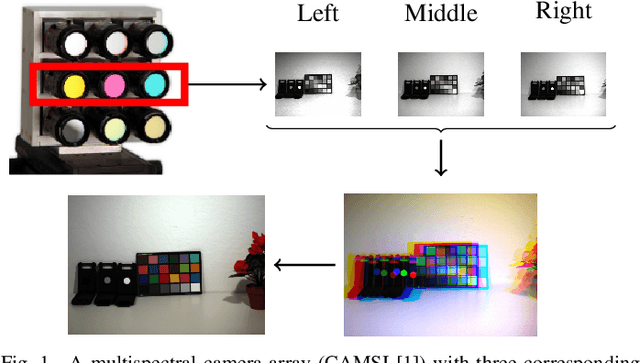
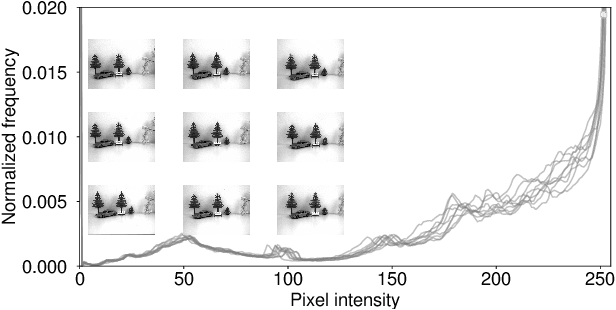
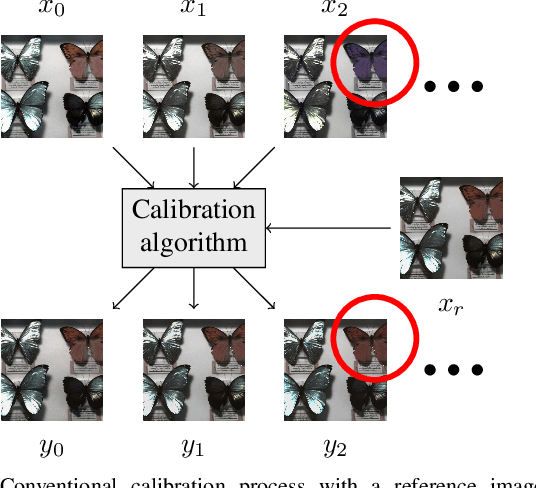

Abstract:This paper introduces a novel method for inter-camera color calibration for multispectral imaging with camera arrays using a consensus image. Capturing images using multispectral camera arrays has gained importance in medical, agricultural, and environmental processes. Due to fabrication differences, noise, or device altering, varying pixel sensitivities occur, influencing classification processes. Therefore, color calibration between the cameras is necessary. In existing methods, one of the camera images is chosen and considered as a reference, ignoring the color information of all other recordings. Our new approach does not just take one image as reference, but uses statistical information such as the location parameter to generate a consensus image as basis for calibration. This way, we managed to improve the PSNR values for the linear regression color correction algorithm by 1.15 dB and the improved color difference (iCID) values by 2.81.
Conditional Optimal Filter Selection for Multispectral Object Classification
Oct 02, 2024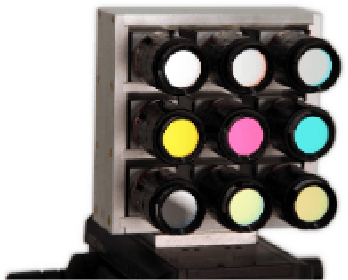
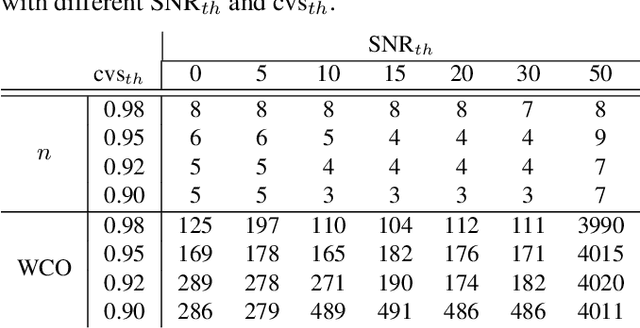
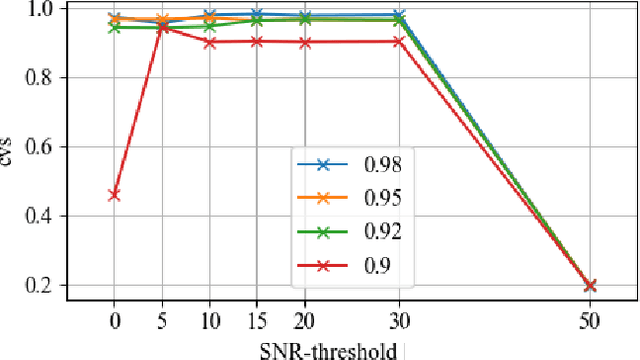
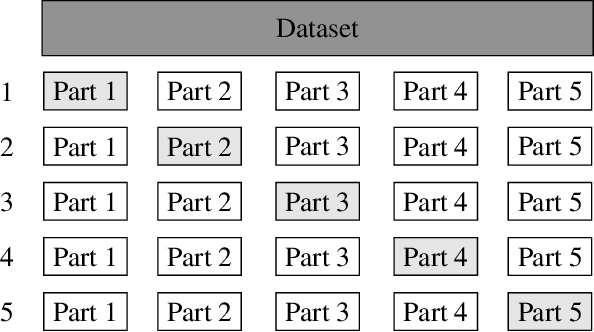
Abstract:Capturing images using multispectral camera arrays has gained importance in medical, agricultural and environmental processes. However, using all available spectral bands is infeasible and produces much data, while only a fraction is needed for a given task. Nearby bands may contain similar information, therefore redundant spectral bands should not be considered in the evaluation process to keep complexity and the data load low. In current methods, a restricted and pre-determined number of spectral bands is selected. Our approach improves this procedure by including preset conditions such as noise or the bandwidth of available filters, minimizing spectral redundancy. Furthermore, a minimal filter selection can be conducted, keeping the hardware setup at low costs, while still obtaining all important spectral information. In comparison to the fast binary search filter band selection method, we managed to reduce the amount of misclassified objects of the SMM dataset from 318 to 124 using a random forest classifier.
Fast Edge-Aware Occlusion Detection in the Context of Multispectral Camera Arrays
Aug 26, 2024



Abstract:Multispectral imaging is very beneficial in diverse applications, like healthcare and agriculture, since it can capture absorption bands of molecules in different spectral areas. A promising approach for multispectral snapshot imaging are camera arrays. Image processing is necessary to warp all different views to the same view to retrieve a consistent multispectral datacube. This process is also called multispectral image registration. After a cross spectral disparity estimation, an occlusion detection is required to find the pixels that were not recorded by the peripheral cameras. In this paper, a novel fast edge-aware occlusion detection is presented, which is shown to reduce the runtime by at least a factor of 12. Moreover, an evaluation on ground truth data reveals better performance in terms of precision and recall. Finally, the quality of a final multispectral datacube can be improved by more than 1.5 dB in terms of PSNR as well as in terms of SSIM in an existing multispectral registration pipeline. The source code is available at \url{https://github.com/FAU-LMS/fast-occlusion-detection}.
High-Resolution Hyperspectral Video Imaging Using A Hexagonal Camera Array
Jul 12, 2024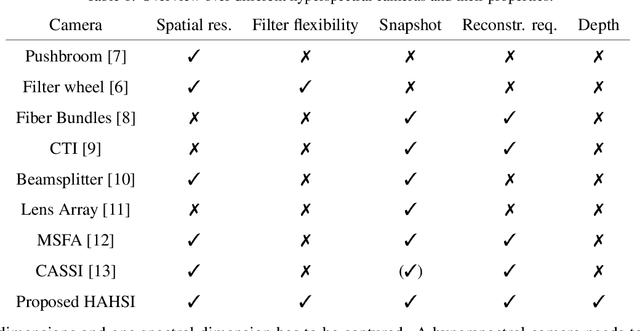
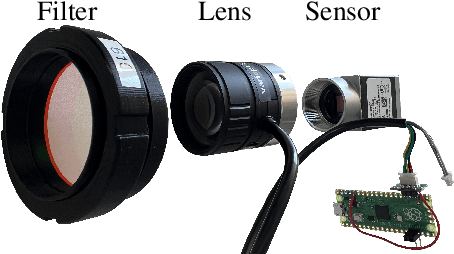
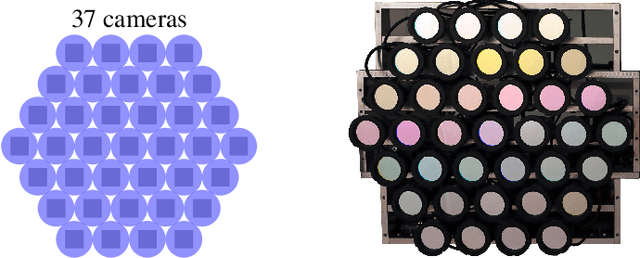

Abstract:Retrieving the reflectance spectrum from objects is an essential task for many classification and detection problems, since many materials and processes have a unique spectral behaviour. In many cases, it is highly desirable to capture hyperspectral images due to the high spectral flexibility. Often, it is even necessary to capture hyperspectral videos or at least to be able to record a hyperspectral image at once, also called snapshot hyperspectral imaging, to avoid spectral smearing. For this task, a high-resolution snapshot hyperspectral camera array using a hexagonal shape is introduced.The hexagonal array for hyperspectral imaging uses off-the-shelf hardware, which enables high flexibility regarding employed cameras, lenses and filters. Hence, the spectral range can be easily varied by mounting a different set of filters. Moreover, the concept of using off-the-shelf hardware enables low prices in comparison to other approaches with highly specialized hardware. Since classical industrial cameras are used in this hyperspectral camera array, the spatial and temporal resolution is very high, while recording 37 hyperspectral channels in the range from 400 nm to 760 nm in 10 nm steps. A registration process is required for near-field imaging, which maps the peripheral camera views to the center view. It is shown that this combination using a hyperspectral camera array and the corresponding image registration pipeline is superior in comparison to other popular snapshot approaches. For this evaluation, a synthetic hyperspectral database is rendered. On the synthetic data, the novel approach outperforms its best competitor by more than 3 dB in reconstruction quality. This synthetic data is also used to show the superiority of the hexagonal shape in comparison to an orthogonal-spaced one. Moreover, a real-world high resolution hyperspectral video database is provided.
A Study on the Effect of Color Spaces in Learned Image Compression
Jun 19, 2024


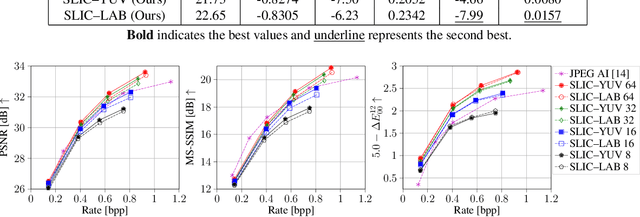
Abstract:In this work, we present a comparison between color spaces namely YUV, LAB, RGB and their effect on learned image compression. For this we use the structure and color based learned image codec (SLIC) from our prior work, which consists of two branches - one for the luminance component (Y or L) and another for chrominance components (UV or AB). However, for the RGB variant we input all 3 channels in a single branch, similar to most learned image codecs operating in RGB. The models are trained for multiple bitrate configurations in each color space. We report the findings from our experiments by evaluating them on various datasets and compare the results to state-of-the-art image codecs. The YUV model performs better than the LAB variant in terms of MS-SSIM with a Bj{\o}ntegaard delta bitrate (BD-BR) gain of 7.5\% using VTM intra-coding mode as the baseline. Whereas the LAB variant has a better performance than YUV model in terms of CIEDE2000 having a BD-BR gain of 8\%. Overall, the RGB variant of SLIC achieves the best performance with a BD-BR gain of 13.14\% in terms of MS-SSIM and a gain of 17.96\% in CIEDE2000 at the cost of a higher model complexity.
Multispectral Snapshot Image Registration Using Learned Cross Spectral Disparity Estimation and a Deep Guided Occlusion Reconstruction Network
Jun 17, 2024
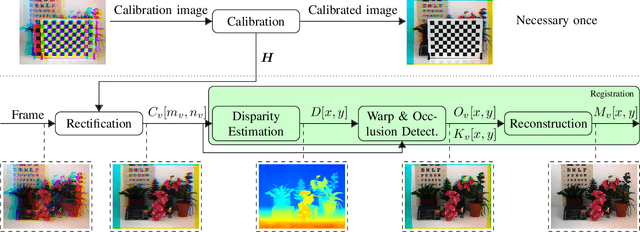


Abstract:Multispectral imaging aims at recording images in different spectral bands. This is extremely beneficial in diverse discrimination applications, for example in agriculture, recycling or healthcare. One approach for snapshot multispectral imaging, which is capable of recording multispectral videos, is by using camera arrays, where each camera records a different spectral band. Since the cameras are at different spatial positions, a registration procedure is necessary to map every camera to the same view. In this paper, we present a multispectral snapshot image registration with three novel components. First, a cross spectral disparity estimation network is introduced, which is trained on a popular stereo database using pseudo spectral data augmentation. Subsequently, this disparity estimation is used to accurately detect occlusions by warping the disparity map in a layer-wise manner. Finally, these detected occlusions are reconstructed by a learned deep guided neural network, which leverages the structure from other spectral components. It is shown that each element of this registration process as well as the final result is superior to the current state of the art. In terms of PSNR, our registration achieves an improvement of over 3 dB. At the same time, the runtime is decreased by a factor of over 3 on a CPU. Additionally, the registration is executable on a GPU, where the runtime can be decreased by a factor of 111. The source code and the data is available at https://github.com/FAU-LMS/MSIR.
A Guided Upsampling Network for Short Wave Infrared Images Using Graph Regularization
Dec 14, 2023



Abstract:Exploiting the infrared area of the spectrum for classification problems is getting increasingly popular, because many materials have characteristic absorption bands in this area. However, sensors in the short wave infrared (SWIR) area and even higher wavelengths have a very low spatial resolution in comparison to classical cameras that operate in the visible wavelength area. Thus, in this paper an upsampling method for SWIR images guided by a visible image is presented. For that, the proposed guided upsampling network (GUNet) uses a graph-regularized optimization problem based on learned affinities is presented. The evaluation is based on a novel synthetic near-field visible-SWIR stereo database. Different guided upsampling methods are evaluated, which shows an improvement of nearly 1 dB on this database for the proposed upsampling method in comparison to the second best guided upsampling network. Furthermore, a visual example of an upsampled SWIR image of a real-world scene is depicted for showing real-world applicability.
Color Agnostic Cross-Spectral Disparity Estimation
Dec 14, 2023Abstract:Since camera modules become more and more affordable, multispectral camera arrays have found their way from special applications to the mass market, e.g., in automotive systems, smartphones, or drones. Due to multiple modalities, the registration of different viewpoints and the required cross-spectral disparity estimation is up to the present extremely challenging. To overcome this problem, we introduce a novel spectral image synthesis in combination with a color agnostic transform. Thus, any recently published stereo matching network can be turned to a cross-spectral disparity estimator. Our novel algorithm requires only RGB stereo data to train a cross-spectral disparity estimator and a generalization from artificial training data to camera-captured images is obtained. The theoretical examination of the novel color agnostic method is completed by an extensive evaluation compared to state of the art including self-recorded multispectral data and a reference implementation. The novel color agnostic disparity estimation improves cross-spectral as well as conventional color stereo matching by reducing the average end-point error by 41% for cross-spectral and by 22% for mono-modal content, respectively.
RGB-Guided Resolution Enhancement of IR Images
Sep 12, 2023



Abstract:This paper introduces a novel method for RGB-Guided Resolution Enhancement of infrared (IR) images called Guided IR Resolution Enhancement (GIRRE). In the area of single image super resolution (SISR) there exists a wide variety of algorithms like interpolation methods or neural networks to improve the spatial resolution of images. In contrast to SISR, even more information can be gathered on the recorded scene when using multiple cameras. In our setup, we are dealing with multi image super resolution, especially with stereo super resolution. We consider a color camera and an IR camera. Current IR sensors have a very low resolution compared to color sensors so that recent color sensors take up 100 times more pixels than IR sensors. To this end, GIRRE increases the spatial resolution of the low-resolution IR image. After that, the upscaled image is filtered with the aid of the high-resolution color image. We show that our method achieves an average PSNR gain of 1.2 dB and at best up to 1.8 dB compared to state-of-the-art methods, which is visually noticeable.
Conditional Residual Coding: A Remedy for Bottleneck Problems in Conditional Inter Frame Coding
Jul 24, 2023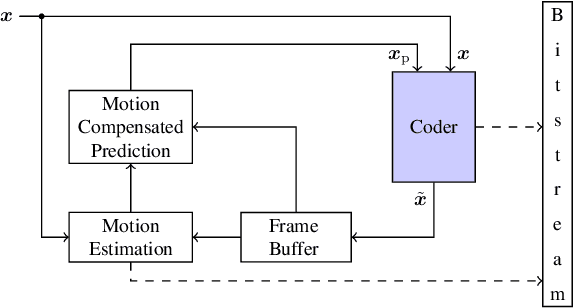
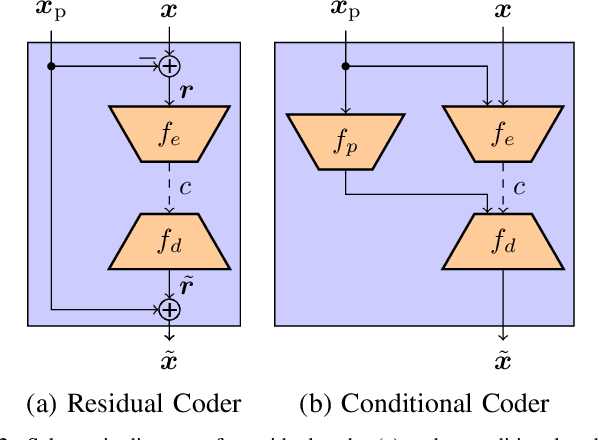
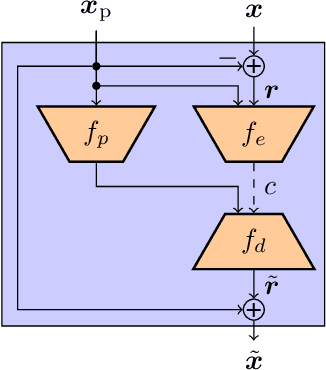
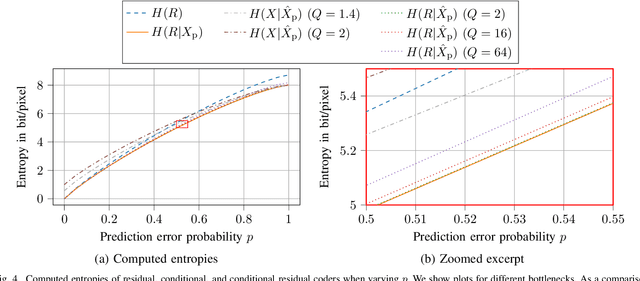
Abstract:Conditional coding is a new video coding paradigm enabled by neural-network-based compression. It can be shown that conditional coding is in theory better than the traditional residual coding, which is widely used in video compression standards like HEVC or VVC. However, on closer inspection, it becomes clear that conditional coders can suffer from information bottlenecks in the prediction path, i.e., that due to the data processing inequality not all information from the prediction signal can be passed to the reconstructed signal, thereby impairing the coder performance. In this paper we propose the conditional residual coding concept, which we derive from information theoretical properties of the conditional coder. This coder significantly reduces the influence of bottlenecks, while maintaining the theoretical performance of the conditional coder. We provide a theoretical analysis of the coding paradigm and demonstrate the performance of the conditional residual coder in a practical example. We show that conditional residual coders alleviate the disadvantages of conditional coders while being able to maintain their advantages over residual coders. In the spectrum of residual and conditional coding, we can therefore consider them as ``the best from both worlds''.
 Add to Chrome
Add to Chrome Add to Firefox
Add to Firefox Add to Edge
Add to Edge